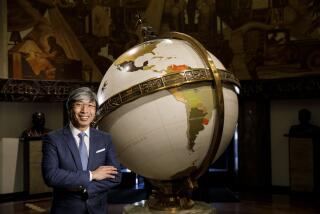Winners of the L.A. Times’ 2012 Editorial Awards
The Los Angeles Times’ Editorial Awards for 2012 were presented in a ceremony Thursday night, honoring the newsroom’s best work from the past year.
At the ceremony, Editor Davan Maharaj announced a new honor, the Editor’s Award for Persistence, which he dubbed the Golden Cockroach Award.
“The cockroach can’t be exterminated and can’t be stopped,” he said. “You can stomp on them, take their food away, and deny their document requests -- but they’re still there at the end of the day. Sounds a lot like many journalists over the last 10 years. And like many people in this room. Faced with obstacles, we overcome. Beaten down, we rise again.”
The winners: The Times’ 2012 political team.
Maharaj quoted from a Columbia Journalism Review column by Walter Shapiro to announce the winners:
“My enthusiasm for the LA Times’ political coverage is becoming a Johnny-one-note obsession. Several times I have commended Matea Gold and her colleagues on the money-in-politics beat for their against-the-grain curiosity about how political consultants were getting rich from this $6 billion campaign year. But it was also the smartness of the newspaper’s day-to-day coverage, as shown in stories like Michael Finnegan’s fast-off-the-mark reporting from Ohio about how the attacks on Bain Capital were hurting Romney. And the paper displayed impressive journalistic self-confidence in debunking obvious lies and misstatements in the middle of news stories, whether they were Donald Trump’s birther rants or Romney’s post-election attack on Barack Obama’s purported “gifts.” What 2012 taught me is that quality political reporting can flower even in forbidding or unlikely terrains. So let me lift a glass to the campaign reporters and editors at the Los Angeles Times, who this year embodied hope and change in journalism.”
Other winners:
Breaking news: National staff, for coverage of the movie theater shootings in Aurora, Colo. Last year, the National staff covered one disaster after another: mass shootings at a Colorado theater, a Sikh Temple in Wisconsin and a Connecticut elementary school; as well as Super Storm Sandy. A constant in all these stories was the energy, dedication and calm professionalism of the National staff as they brought the details, the nuance and the humanity home to readers. They were aided by the Washington bureau, Metro, Calendar, Business, photo, the Web staff, design, news research, the copy desk and the amazing Metpros. The Aurora coverage stands out as one of the finest L.A. Times swarms – a massive response on all fronts and platforms, with every department contributing.
Opinion journalism (two winners): Michael Hiltzik, whose commentaries in The Times’ Business section marshal original reporting and critical analysis to illuminate complex and important issues with a forceful point of view.
Mary McNamara, for her searching television criticism that often becomes a springboard for provocative comments on the culture at large. She can make us laugh; she can make us cry; and just as importantly she can make us think.
Explanatory journalism: Calendar staff, for “Inside the Academy.” The Academy of Motion Picture Arts and Sciences is Hollywood’s most influential organization. Its Oscars show is watched by millions. But who, exactly, votes on these awards? The Academy refused to release its roster, so reporters made thousands of phone calls to get the answer. In the end, the team tracked down nearly 90% of the group’s almost 5,800 voting members. What they found was revealing: Oscar voters were nearly 94% Caucasian and 77% male. Blacks composed about 2% of the Academy, and Latinos less than 2%. Perhaps most important, the study prompted the Academy to action, with its leaders telling The Times they planned to use the study to start remaking the organization.
Investigations: Kim Christensen, Jason Felch, Maloy Moore and Ken Schwencke, for “Shame of the Boy Scouts,” which revealed the contents of thousands of files documenting sexual abuse in one of the nation’s most revered youth organizations. After making meticulous redactions to protect the victims, Times journalists posted a database of 5,000 case files. Within days, more than 100,000 readers had searched those files.
Feature writing: Molly Hennessy-Fiske, for “Standing Up: Davien’s Story.” When Hennessy-Fiske first met Davien Graham, he was 16 and in a hospital bed, paralyzed and unsure of his future. Five years would pass between that meeting and his decision to testify in court, testimony that sent his assailant to prison. Hennessy-Fiske turned a tragic gang-related shooting in Monrovia into a dramatic tale of fear, courage and moral uplift.
Sports reporting: Kevin Baxter, whose versatility keeps him moving from one arena to another. He’s comfortable covering soccer, baseball, football, basketball, boxing, Olympic sports ... virtually anything. As The Times’ primary soccer writer, he has a deep and broad knowledge of the sport in this country and abroad. And as a key member of our team in London, he wrote some of our best pieces on the 2012 Olympics.
Beat reporting: Richard Marosi and Don Bartletti, who illuminated another side of illegal immigration in their series “Without a Country.” The pair had covered the U.S.-Mexico border for years, and the tide of unauthorized immigrants had always flowed one way: north. But in bus stops and cantinas from California to Texas, they heard another side to the story: Young men with no memory of any home other than the United States suddenly landing on the other side of the border, in a land both strange and hard.
Blog: L.A. Now, for keeping readers up to date on breaking news around the clock.
Blogging by an individual: Tiffany Hsu, for Money & Co. Hsu was one of The Times’ most-read writers of the year – attacking a wide range of subjects including major Dow closings, online poker scams, and Chick-fil-A and gay marriage. Because of her high-octane approach, she brought millions of new readers to The Times.
Social media: Mike Bresnahan. To be great in social media, you have to have personality, reply to readers, break news, tweet live from events, and stay in the game outside of business hours. Bresnahan did all that and more – and he doubled his followers after focusing on Twitter late in the year. The results are a loyal audience that considers his beat coverage of the Lakers to be essential reading.
Graphics: Armand Emamdjomeh, Thomas Suh Lauder, Anthony Pesce, Ken Schwencke and Ben Welsh, for Election 2012. In a series of online graphics and maps, readers following the presidential election got a sophisticated look at how the nation voted – and who was paying the campaign bills. They could track half a billion dollars in SuperPac spending – and the attack ads it funded. They could watch live results from the primaries through election night – on desktop and mobile devices. Even the California propositions guide was mobile. This team did all this, and, in the best spirit of digital journalism, created an open-source tool that let small news organizations create their own maps.
Video: Rick Loomis, Albert Lee, Liz O. Baylen and Kenneth Weiss, for “Beyond 7 Billion.” In six short films that explore population growth around the world, this group set a new standard for our most ambitious and informative work. The scenes stay with anyone who has watched them: the struggle to overcome poverty and child marriage in India, the drama of birth in a Manila hospital ward, the determination of Kenyan women trying to control their own fertility, the environmental toll exacted by China’s rapidly expanding middle class. And – perhaps most indelibly – the death of a 2-year-old Somali boy at a refugee camp hospital.
Digital presentation: Myung J. Chun, Lorena Iñiguez Elebee, Christopher Hawthorne, Lily Mihalik, Anthony Pesce, Paul Duginski and Luis Sinco, for “Boulevards.” Hawthorne discovered a new city – a Los Angeles in which your car matters less by the day. From the sidewalks of Atlantic Boulevard to what little remains of an 1800s adobe on Lankershim, the digital presentation brought together the best of all disciplines: great storytelling, sharp graphics, photos, video and engaging maps bound up in an innovative design.
Print presentation: Wes Bausmith and Jan Molen, for their ambitious approach to visual storytelling in the Saturday section.
Copy editing: Paul Ybarrondo, a talented text editor and headline writer, for his work on the A1 desk, making The Times’ front pages sparkle.
Headline writing: Steve Horn of the Sports desk. In a big game, with the clock running down, you want to make sure your star player is in control. That’s also true in The Times’ Sports section, where Horn is a master of making the big type sing. His headline for a story about the Lakers’ grisly win over a lowly opponent: “Close, but no scars.” And his headline for a story about the Angels’ moves to add another slugger to their lineup: “More power to them”
News photography: Photo staff, for coverage of Space Shuttle Endeavour. How do you cover something that has never happened before, that no one will give you any information about, and that authorities have vowed to deny access to? That was the photo staff’s challenge in chronicling Endeavour’s final journey, to the California Science Center. Twenty-six 26 photographers and 18,000 photos later, the Los Angeles Times photo department produced a masterpiece that not only was visually stunning but actually brought the city together.
Feature photography: Liz O. Baylen, whose photos with the series “Dying for Relief” took readers deep into the lives of patients trapped by their prescription drug addictions. She chose her moments carefully: a patient’s bedroom with its night table and dresser covered with pill bottles; a young man whose grimace conveys the pain of withdrawal; a mother and father hunched over the tailgate of the truck in which their son’s body lies, waiting to be taken to a funeral home. The photos open up the twilight world of addiction and the ghost clinics and pill mills that support it.
Assignment editing: Rich Connell, an assistant Metro editor who loves a good story, even when it’s complicated and far from a sure thing. His loyalty to telling those stories – and to the reporters who write them – produced some of the best local government coverage in years. The Times set the agenda with our series on problems in the Fire Department’s 911 system; our coverage of the city’s financial crisis; the mayor’s race; the region’s light-rail system; risky, high-cost borrowing by school districts; and the effect of Obamacare on local health clinics.
Visual editing: Mary Vignoles, who has a passion for telling important stories – and for pushing photographers to new heights. Her talent and dedication fostered some of our finest visual journalism in 2012: “Dying for Relief;” the slums of Rio de Janeiro; the story of Jesus Garcia, a young man facing imminent death; and the struggles of a family coping with a father’s fatal brain disease.
Scoop of the year: David Zucchino, “U.S. troops posed with body parts of Afghan bombers” It started with someone who knew Zucchino’s byline, trusted him and slipped him some information, including photos. The implications were serious. But before any story could be published, every sliver of information had to be checked, every person in more than 20 photos had to be contacted. That was the easy part. Then, the brain trust of the U.S. war effort was thrown at The Times. We were warned that if we published the story, Zucchino might never get to return on a U.S. embed in Afghanistan. But Zucchino wasn’t here to accept his award -- he’s on a U.S. embed in Afghanistan.
Editor’s prize: Lisa Girion, Scott Glover, Hailey Branson-Potts, Doug Smith, Sandra Poindexter, Matt Lait and Liz O. Baylen: “Dying for Relief.” This group of journalists showed how greedy or incompetent physicians over-prescribe addictive drugs, how pharmacists fill prescriptions they know to be excessive, and how state regulators have done little to stem a tragedy unfolding before their eyes. Citing our reporting, the state medical board issued an extraordinary appeal to Californians to report reckless prescribing by physicians. Using our articles as a road map, the board has also begun investigating deaths linked to prolific prescribers. And legislation to give the board more investigators and greater authority to rein in reckless prescribing is moving through Sacramento.
President’s prize: Robert J. Lopez, Kate Linthicum, Ben Welsh and Rich Connell: “Life on the Line: 911 Breakdowns at the LAFD.” A team of Times journalists, combining dogged street reporting with sophisticated data analysis, discovered that the Los Angeles Fire Department’s emergency medical response system had been terrible for years. In the precious minutes between the ideal and the real, lives were being lost. The Times built an online map where readers could see the average response time, block by block. We released the computer code that powered that map and our database so that members of the public, and other news outlets, could investigate emergency response times in their neighborhoods and cities. In response, the mayor and City Council reallocated millions of dollars to improve Fire Department computer systems and to restore ambulances that had been idled by budget cuts. And a new analysis unit was established to give Fire Department commanders reliable data on 911 response times.
Publisher’s prize: Raja Abdulrahim, for her reporting from Syria. When civil war broke out in Syria, journalists from around the world made their way there. Abdulrahim was determined to bear witness. For reasons of security, she wrote her stories without a byline. She spent months making risky trips into Syria from neighboring countries. She took a three-hour hike through the mountains from Lebanon. She snuck in on the back of a motorcycle. She tramped across the rugged frontier with Turkey. She lived with the rebels as they fought for an uncertain future. Her stories are an unforgettable portrait of a people so steeped in fear that they finally had nothing to lose. Her work was in the finest tradition of foreign reporting – courageous, meticulous, relentless.
Hoy:
Beat Reporting: Soudi Jiménez
Design: Heiner Rodas
Editor’s Prize: Andrea Carrión
TCN South:
News Reporting: Alisha Gomez
Sports Reporting: Mike Sciacca
Editor’s Award: Don Leach
TCN North:
Sports Reporting: Andrew Campa
Photography: Raul Roa
Editor’s Award: Jason Wells
[Updated, April 19, 2013: This post has been updated to include the announcements of the Golden Cockroach Award, and Scoop of the Year.]




